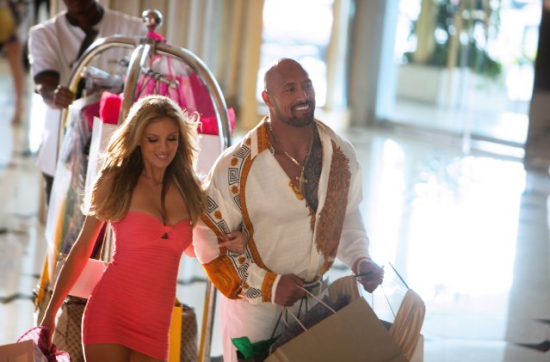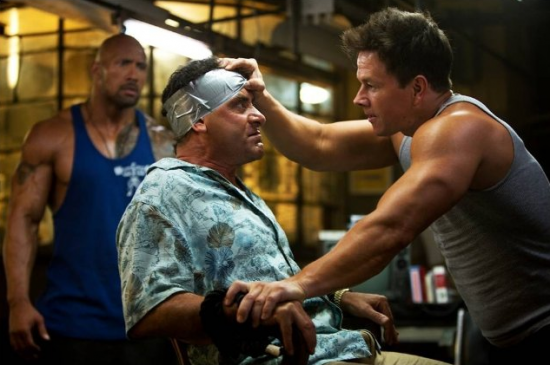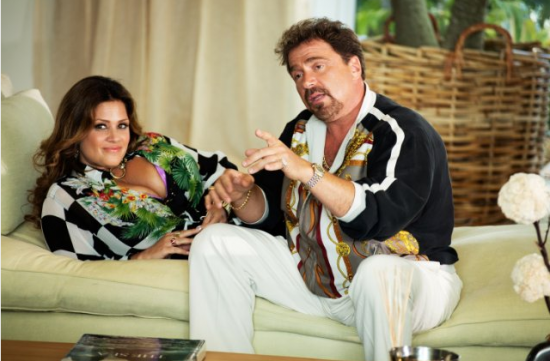Four Differences Between 'Pain And Gain' And Real Life, And What They Say About Michael Bay
To say that Pain & Gain is Michael Bay's most restrained film in six years is either an indictment of the devolution of Bay's directorial career or an earnest wish that he return to making movies without giant fighting robots. Despite its pedigree, the film is an enjoyable, misanthropic, frequently uncomfortable testosterone-laden romp through the streets of 90s-era Miami. It feels like the type of film Bay was born to make, before he got in bed with Hasbro.
One of the most fascinating aspects of Pain & Gain is that it's based on a true story, featuring characters that are still alive today. How a filmmaker chooses to depict real-life events can say a lot about the filmmaker and how the events themselves still resonate. According to Bay, "Pain & Gain is a mixture of Fargo and Pulp Fiction. It's a dark comedy, and it's all true."
But how accurate is the film, really? I spent a couple of hours reading Pete Collins' Pain and Gain, a riveting feature he wrote for the Miami New Times in 2000 (you can read Part 1, Part 2, and Part 3 on the internet). In the screenplay, written by Christopher Markus and Stephen McFeely, the standard liberties are taken with the source material: characters were combined or excluded completely based on how they served the plot, and many of the more mundane events were eliminated as well. To see what I thought were the most significant divergences, read past the jump.
Note: Massive spoilers for Pain and Gain follow. Carl Weekes is a weakling – In reality, the third man in the Sun Gym Gang was a man named Carl Weekes, who most closely resembles the Paul Doyle character in the film — both are trying to make a new life in Miami, and both are born again Christians. But Weekes is a weakling; Collins describes him as "a lightweight" who weighed only 140. Moreover, he's almost totally excluded from the later events in the story, in which sex mogul Frank Griga is killed. In the film, Weekes/Doyle is played by Dwayne Johnson, a hulking, spastic, hilarious presence, who involves himself throughout the proceedings.What it tells us about Michael Bay: Bay recognized what many directors have already concluded: that Dwayne Johnson is a genuine movie star with charisma to spare, whose ascension now appears to be unstoppable. Besides that inspired casting choice, the trio of characters have great chemistry together in the film, which would've been completely absent had Bay and the screenwriters hewed too closely to real-life events.
Carl Weekes is a weakling – In reality, the third man in the Sun Gym Gang was a man named Carl Weekes, who most closely resembles the Paul Doyle character in the film — both are trying to make a new life in Miami, and both are born again Christians. But Weekes is a weakling; Collins describes him as "a lightweight" who weighed only 140. Moreover, he's almost totally excluded from the later events in the story, in which sex mogul Frank Griga is killed. In the film, Weekes/Doyle is played by Dwayne Johnson, a hulking, spastic, hilarious presence, who involves himself throughout the proceedings.What it tells us about Michael Bay: Bay recognized what many directors have already concluded: that Dwayne Johnson is a genuine movie star with charisma to spare, whose ascension now appears to be unstoppable. Besides that inspired casting choice, the trio of characters have great chemistry together in the film, which would've been completely absent had Bay and the screenwriters hewed too closely to real-life events. Gay stuff - The film contains a number of homosexual references that are totally absent from the original story: Doyle's priest makes unwanted sexual advances towards him, which results in a brutal assault; the warehouse where Victor Kershaw is held houses a plethora of dildos.What it tells us about Michael Bay: Bay still finds homosexuality, and the homophobia from his characters that usually accompanies it, to be freaking hilarious.
Gay stuff - The film contains a number of homosexual references that are totally absent from the original story: Doyle's priest makes unwanted sexual advances towards him, which results in a brutal assault; the warehouse where Victor Kershaw is held houses a plethora of dildos.What it tells us about Michael Bay: Bay still finds homosexuality, and the homophobia from his characters that usually accompanies it, to be freaking hilarious. Doyle's Toe - In the last third of the film, Doyle runs out of cash and decides to rob an armored truck to get a much-needed cash infusion. A madcap series of events follows, resulting in Doyle getting a dye pack exploded into his face, followed by him getting his toe shot off. Doyle then inexplicably feeds his toe to Frank Grin's dog, an act that is later discovered by Grin's housekeeper. In the real-life story, the maid enters the house only to be shocked to discover it has been completely trashed. She finds the couple's passports, and concludes that their business deal with the Sun Gym gang probably went sideways.What it tells us about Michael Bay: The Doyle/toe incident injects a third-act action beat into the story. Maybe Bay thought that in a film with torture, killing, drugs, and sex, there wasn't already enough going on to maintain the audience's interest? Also, between this and the cadaver/van scene in Bad Boys II, it's clear that Bay has a passion for severed body parts.
Doyle's Toe - In the last third of the film, Doyle runs out of cash and decides to rob an armored truck to get a much-needed cash infusion. A madcap series of events follows, resulting in Doyle getting a dye pack exploded into his face, followed by him getting his toe shot off. Doyle then inexplicably feeds his toe to Frank Grin's dog, an act that is later discovered by Grin's housekeeper. In the real-life story, the maid enters the house only to be shocked to discover it has been completely trashed. She finds the couple's passports, and concludes that their business deal with the Sun Gym gang probably went sideways.What it tells us about Michael Bay: The Doyle/toe incident injects a third-act action beat into the story. Maybe Bay thought that in a film with torture, killing, drugs, and sex, there wasn't already enough going on to maintain the audience's interest? Also, between this and the cadaver/van scene in Bad Boys II, it's clear that Bay has a passion for severed body parts. The Schiller Twist – Reading through Pete Collins' Pain & Gain story, I thought I had a pretty good handle on the direction it was going in. I was shocked to discover that at the end, in an M. Night Shyamalan-like twist, the Kershaw character is arrested immediately after he testifies against the Sun Gym gang and charged with a fraudulent Medicare scheme that generated $14 million. It's stunning and a little bit heartbreaking. As Collins writes, "[A]ll he could think was that [the State Attorney General] had sold him out. For three years she had used him, forced him to relive every excruciating detail of his confinement: the starvation, the burns and electric shocks, the beatings, the abject terror, the absolute physical and psychological mortification. She had extracted everything she could, and then she had disposed of him."What it tells us about Michael Bay: Bay has always had a fetishistic appreciation of the fine folks in the U.S. law enforcement and military. In classic form, the opening and closing of Pain & Gain have some pretty spectacularly choreographed shots of police officers in full regalia. The moral of the story is explicitly clear in the film: the police messed up real good, but they made up for it by finally getting their man in the end. Kershaw is already an asshole in the film. Making him into a criminal on a massive scale would have brought a dose of moral ambiguity into things. And we all know how Bay feels about moral ambiguity. Wait. No, we don't.
The Schiller Twist – Reading through Pete Collins' Pain & Gain story, I thought I had a pretty good handle on the direction it was going in. I was shocked to discover that at the end, in an M. Night Shyamalan-like twist, the Kershaw character is arrested immediately after he testifies against the Sun Gym gang and charged with a fraudulent Medicare scheme that generated $14 million. It's stunning and a little bit heartbreaking. As Collins writes, "[A]ll he could think was that [the State Attorney General] had sold him out. For three years she had used him, forced him to relive every excruciating detail of his confinement: the starvation, the burns and electric shocks, the beatings, the abject terror, the absolute physical and psychological mortification. She had extracted everything she could, and then she had disposed of him."What it tells us about Michael Bay: Bay has always had a fetishistic appreciation of the fine folks in the U.S. law enforcement and military. In classic form, the opening and closing of Pain & Gain have some pretty spectacularly choreographed shots of police officers in full regalia. The moral of the story is explicitly clear in the film: the police messed up real good, but they made up for it by finally getting their man in the end. Kershaw is already an asshole in the film. Making him into a criminal on a massive scale would have brought a dose of moral ambiguity into things. And we all know how Bay feels about moral ambiguity. Wait. No, we don't.
